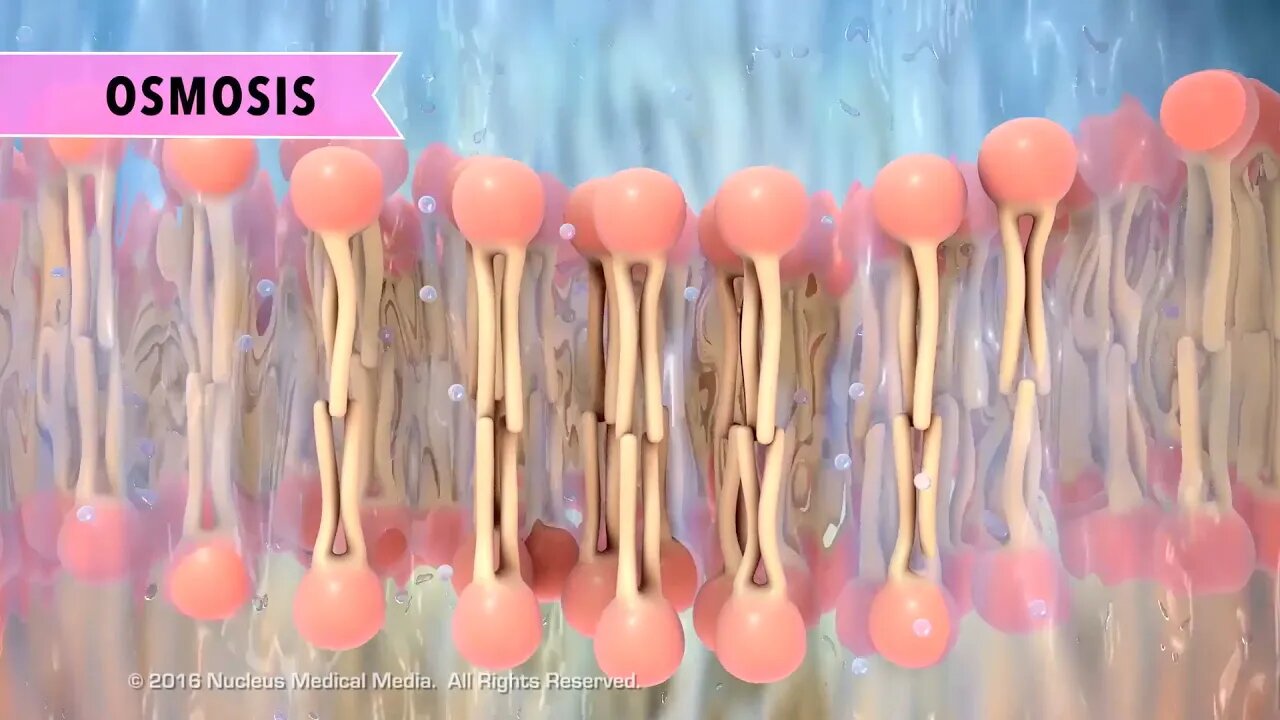Premium Only Content

PassiveTransport
For Employees of hospitals, schools, universities and libraries: download up to 8 FREE medical animations from Nucleus by signing up for a free trial at: http://nmal.nucleusmedicalmedia.com/biology_youtube
SCIENCE ANIMATION TRANSCRIPT: In this video, we will be discussing passive transport. Passive transport is when particles move through the cell membrane from an area of higher concentration to lower concentration without the use of energy, also described as movement along the concentration gradient. What are the types of passive transport? They are diffusion, osmosis, and facilitated diffusion. We'll describe diffusion first using the solution in this container. A solution is a liquid with something dissolved in it. The aqua color represents the solvent, meaning the liquid part of the solution. The yellow particles represent the dissolved substance called the solute. The structure in the middle of the container represents a semi-permeable cell membrane, a barrier through which only certain sized particles can pass freely. It's important to note that although diffusion often occurs across the cell membrane, diffusion can happen with or without a semi-permeable membrane. Right now, there is more solute on the left than there is on the right. Because solute particles are able to pass through the semi-permeable membrane, they are going to naturally move from an area of high concentration to an area of low concentration. They will continue to do this until both sides of the container have about equal numbers of solute particles. This is called achieving a state of equilibrium. Let's review what we've covered so far. Diffusion is when particles move from an area of high concentration to low concentration. This just happens. It's a natural process that doesn't use any energy. Here's an example of diffusion happening without a semi-permeable membrane. If you spray air freshener in a room, people near you smell it right away. But after a short time, depending on the size of the room, people farther away will also begin to smell it. This is because the little scented molecules are trying to achieve equilibrium by spreading evenly throughout the room. Remember, diffusion is a natural process, like a ball rolling down a hill. The ball's movement is automatic and doesn't require any energy. Osmosis is diffusion that happens with water molecules. Let's look at another container in which the solvent is water but the solute particles are larger. The membrane in this container has openings that are too small for the solute to move through, but water can pass through the membrane freely. This time, we'll focus on the concentration gradient of the water rather than the solute particles. Although the large solute particles can't pass through the membrane, the water molecules are small enough to pass through. The water moves freely from its area of high concentration to low concentration until equilibrium is reached. Equilibrium means that the proportion of water to solute particles is about the same on both sides of the membrane. In the cell, osmosis means diffusion of water through the cell membrane. Water can enter or leave the cell through the membrane until the cell achieves a state of equilibrium with its surroundings. So like diffusion, osmosis is passive. No energy is required. It just happens automatically. Facilitated diffusion is a type of passive transport in which molecules diffuse through specialized protein channels in the cell membrane. The protein channels work like special ports or tunnels that allow these substances in or out of the cell. Facilitated diffusion is also when particles move from high concentration to low concentration. How do you know that? From the word "diffusion." Facilitated diffusion works naturally without added energy, just like the diffusion example we discussed earlier. But facilitated diffusion generally happens with particles a bit larger than those that can seep through the cell membrane's phospholipid layers. So they move in or out of the cell along the concentration gradient in a specialized way through protein channels. In summary, passive transport is a natural process that doesn't require the cell to expend any energy. The types of passive transport are diffusion, osmosis, and facilitated diffusion. [music]
NSV15008
-
 LIVE
LIVE
Jeff Ahern
1 hour agoFriday Freak out with Jeff Ahern
247 watching -
 1:29:00
1:29:00
Russell Brand
4 hours agoLaura Loomer: The Most Banned Woman in the World - SF632
71.8K97 -
 2:44:08
2:44:08
Robert Gouveia
4 hours agoCharlie's Murderer CAUGHT! Name and Details RELEASED! Deranged Libs FIRED!
19.7K15 -
 2:14:43
2:14:43
The Quartering
3 hours agoCharlie KIrk Assassin CAUGHT, Motive Revealed, Who He Was & His Confession
83.8K87 -
 1:34:19
1:34:19
Sean Unpaved
3 hours agoTNF Recap: Packers Roll, Commanders Crumble & NFL/CFB's Week 2-3 Predictions
46K -
 2:07:09
2:07:09
The Culture War with Tim Pool
4 hours agoCharlie Kirk Suspect Captured, Antifa Confirmed | The Culture War with Tim Pool
156K163 -
 1:50:59
1:50:59
Steven Crowder
6 hours agoBREAKING: Shooter Caught & Shooting Eyewitness Joins to Discuss What He Saw
694K669 -
 2:27:40
2:27:40
Reidboyy
4 hours ago $0.43 earnedHow To Make $$$ in Delta Force Console Operations!
27.6K -
 1:43:50
1:43:50
The Mel K Show
4 hours agoMORNINGS WITH MEL K - Desperate Globalist Agenda Continues Unabated as Manufactured Chaos Abounds 9-12-25
62.6K9 -
 2:55:00
2:55:00
Benny Johnson
6 hours ago🚨Charlie Kirk's Killer CAUGHT: FBI Press Conference LIVE Right NOW | Trump Demands DEATH PENALTY
217K432